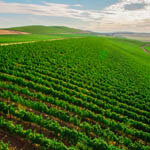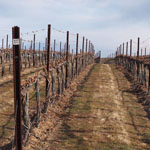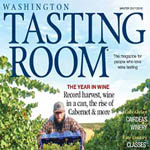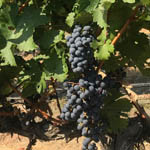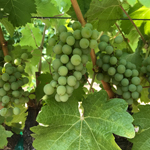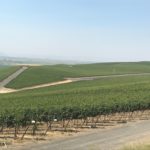 You’ve got to love Washington viticulture. In the last seven growing seasons, we have had the hottest year, even hotter year, coldest year, hail, combination hottest and coldest years, rainy harvests, dry harvests and all the weather-related record events that go with such years. To grow the best grapes here in Washington, one must be ever mindful of all aspects of quality grape growing, expect the unexpected, and be ready to react. In other words, you have to stay on the balls of your feet!
You’ve got to love Washington viticulture. In the last seven growing seasons, we have had the hottest year, even hotter year, coldest year, hail, combination hottest and coldest years, rainy harvests, dry harvests and all the weather-related record events that go with such years. To grow the best grapes here in Washington, one must be ever mindful of all aspects of quality grape growing, expect the unexpected, and be ready to react. In other words, you have to stay on the balls of your feet!
The 2017 growing season was the mirror image of the 2016 growing season in many ways. The 2016 growing season began hot and dry, then in July turned cool and wet. The 2017 growing season began cool and wet, then in July turned hot and dry. In both cases, we set up vineyard activities to match what we thought the weather was trending towards. Then when July changes hit, we had to slam on the brakes and change strategies in order to achieve the highest wine quality, despite the change in weather.
The 2017 growing season did yield a set of events that have potentially created an award-winning vintage. While we will not know this for a while, here are my impressions of the milestone events that suggest 2017 will be remembered as a banner vintage for Stillwater Creek:
- 2016 was a bumper crop year, with large clusters and high yields. Typically, in a year following a bumper crop year, there will be fewer and smaller clusters, as was the case for the 2017 growing season.
- Spring through early summer was cool and rainy. We had rains about once per week up through June. This lead to fewer berries per cluster, due to rain and cool weather during bloom, which caused more shatter than normal – in other words, fewer berries.
- July hit and the weather turned very hot and dry. This hot, dry weather helped to keep berry size small as we moved towards veraison.
- After veraison, the weather stayed warm and then September cooled down significantly. September days were mild and the nights became cold but not freezing. It is my experience that these harvest conditions often lead to high quality wine, particularly with Cabernet Sauvignon, which is favored by nights near freezing during harvest and mild days with very little rain.
So, the 2017 growing season gave us smaller clusters with fewer and smaller berries. Due to the open nature of the clusters, light was able to penetrate the clusters and color the berries from all sides. The result was very high skin color and a higher than normal surface-to-volume ratio. These fruit characteristics, combined with what I viewed as nearly perfect ripening weather from veraison through harvest, created wine grapes that may stand out as the best fruit I have seen since my arrival in Washington in 2011. My hope is that 2017 will be a “Vintage Year.” Time will tell.
There were other unique factors to the 2017 growing season. One in particular that affected many other vineyard growing decisions was soil moisture. We began the 2017 growing season with over one and one-half feet of snow on the ground. When we pruned in February, there was still over a foot of snow in the vineyard. By bud break, the snow had melted and we had Mike Stewart come to the vineyard to measure soil moisture. The soil moisture profile was full. Additionally, there were rains about once per week. Normally we would irrigate prior to bud break and our normal vineyard irrigation program would begin at bud break. In 2017, we did not begin irrigating until late June. The extra soil moisture affected vineyard operations in many ways, including these three factors:
- Fertilization – Normally we would have added minerals to the pre-bud break irrigation, but we did not want to add more moisture to the soil for fear of creating overly vigorous vines. I did not begin to add minerals, via irrigation, until July.
- Root expansion – This again deals with minerals. The normal pre-bud break irrigation wets a very small area of the soil profile. In 2017, due to the high winter snow fall and early season rains, the entire soil profile was saturated. Our assumption was that the grapevine roots would move throughout the entire soil profile, now full of moisture, and mine minerals that have not been available to the grapevines for many years. Therefore, the decision was made to only apply minerals to the foliage because we did not want to over irrigate or fertilize in order to control vine vigor.
- Irrigation – Began in late June, but only in areas of rocky soils because the deeper soils still had a great deal of water. So, we applied deficit irrigation to the deeper soils while maintaining necessary water to the rocky areas, attempting to maintain uniform growth throughout the vineyard.
Due to the frequency and amount of rain we received through June, we took steps to protect against mildew, and thankfully we were successful. The vineyard did not experience any powdery mildew infections.
When we have contrasting years, such as 2016 and 2017, there is a great deal to learn about grape growing and wine quality, with plenty of food for thought. To me, the 2017 ripening conditions and fruit character were better than in 2016. I am beginning to be less concerned about weather in the early months of the growing season and will pay closer attention to weather patterns beginning in July. I am now moved to take a closer look at our irrigation and fertilization techniques and timing in order to improve wine quality yearly; I liked the look and health of the vines leading into harvest in 2017. We obviously cannot recreate the weather patterns of 2017, but we can work with the weather patterns we have and manage our vineyard operations to recreate, as much as possible, the positive wine grape characters exhibited in 2017.
All in all, I feel 2017 was a very good year for Stillwater Creek Vineyard. For all the potential problems the year presented, our fruit turned out clean and disease free, the quality was excellent, and we met most of our targeted yields without over-producing. Wineries seemed very pleased with the picking and fruit quality. We received a number of compliments this year on the looks of the vineyard, the lack of powdery mildew, the cleanliness and timing of our picking, and most importantly, the fruit quality.
I cannot find much negative with the 2017 season, although it was a very tough season. I feel the year taught us a great deal about fruit quality and how we can manage our vineyard operations to help us grow consistently higher quality fruit.
Ed Kelly
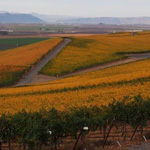 As of today, the 2018 Stillwater Creek Vineyard harvest is complete.
As of today, the 2018 Stillwater Creek Vineyard harvest is complete. 
